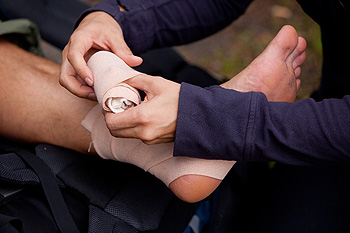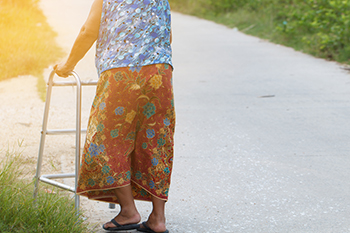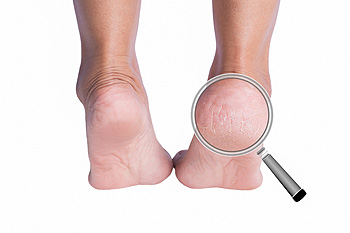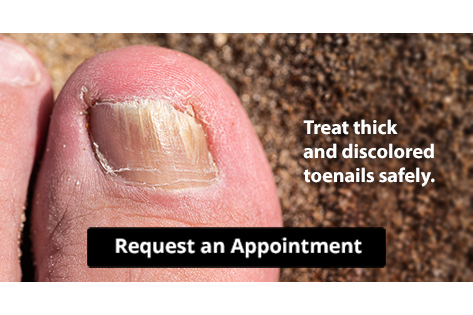Items filtered by date: August 2023
Causes and Symptoms of Tarsal Tunnel Syndrome

Tarsal tunnel syndrome, abbreviated as TTS, is a nerve disorder that can cause discomfort and pain in the foot. Similar to carpal tunnel syndrome in the wrist, TTS involves compression of the tibial nerve in the tarsal tunnel, which is a narrow passage on the inside of the ankle. This compression can result from various factors, including injury, overuse, or having flat feet. Additionally, patients who have diabetes may be susceptible to developing tarsal tunnel syndrome. Individuals who have TTS often report sensations of tingling, burning, or numbness along the inner ankle, which can radiate into the sole of the foot or the toes. Pain may worsen during periods of prolonged standing or activity. Addressing tarsal tunnel syndrome involves getting adequate rest, wearing supportive footwear, and in severe cases, surgery may be necessary. If you suspect you may have tarsal tunnel syndrome, it is suggested that you consult a podiatrist who can provide you with an accurate diagnosis and a tailored treatment plan.
Tarsal tunnel syndrome can be very uncomfortable to live with. If you are experiencing tarsal tunnel syndrome, contact Scott Burdge, DPM of Advanced Ankle & Foot. Our doctor can provide the care you need to keep you pain-free and on your feet.
Tarsal Tunnel Syndrome
Tarsal tunnel syndrome, which can also be called tibial nerve dysfunction, is an uncommon condition of misfiring peripheral nerves in the foot. The tibial nerve is the peripheral nerve in the leg responsible for sensation and movement of the foot and calf muscles. In tarsal tunnel syndrome, the tibial nerve is damaged, causing problems with movement and feeling in the foot of the affected leg.
Common Cause of Tarsal Tunnel Syndrome
- Involves pressure or an injury, direct pressure on the tibial nerve for an extended period of time, sometimes caused by other body structures close by or near the knee.
- Diseases that damage nerves, including diabetes, may cause tarsal tunnel syndrome.
- At times, tarsal tunnel syndrome can appear without an obvious cause in some cases.
The Effects of Tarsal Tunnel Syndrome
- Different sensations, an afflicted person may experience pain, tingling, burning or other unusual sensations in the foot of the affected leg.
- The foot muscles, toes and ankle become weaker, and curling your toes or flexing your foot can become difficult.
- If condition worsens, infections and ulcers may develop on the foot that is experiencing the syndrome.
A physical exam of the leg can help identify the presence of tarsal tunnel syndrome. Medical tests, such as a nerve biopsy, are also used to diagnose the condition. Patients may receive physical therapy and prescriptive medication. In extreme cases, some may require surgery.
If you have any questions please feel free to contact our office located in Katy, TX . We offer the newest diagnostic and treatment technologies for all your foot and ankle needs.
Stop Your Toenail Fungus
Injuries to Lower Extremities From Trampolines

More people are using trampolines for fun and exercise, and this has led to more injuries, especially in children. Many of these injuries are broken bones in the legs. Little kids are at higher risk because they are still learning to balance. Some safety measures like padding and nets are used, but they have not stopped the injuries much. To be safer, it's recommended to have only one person jumping at a time, avoid doing flips, and have someone watching. Many injuries happen when multiple people jump together. Sometimes, bigger people on the trampoline can make smaller ones go too high, leading to hard falls. Some broken bones can lead to long-term problems. Special ankle injuries in young kids can be particularly serious and need surgery. If you or your kids use trampolines, it is suggested that you make an appointment with a podiatrist to learn how to best stay safe.
Sports related foot and ankle injuries require proper treatment before players can go back to their regular routines. For more information, contact Scott Burdge, DPM of Advanced Ankle & Foot. Our doctor can provide the care you need to keep you pain-free and on your feet.
Sports Related Foot and Ankle Injuries
Foot and ankle injuries are a common occurrence when it comes to athletes of any sport. While many athletes dismiss the initial aches and pains, the truth is that ignoring potential foot and ankle injuries can lead to serious problems. As athletes continue to place pressure and strain the area further, a mild injury can turn into something as serious as a rupture and may lead to a permanent disability. There are many factors that contribute to sports related foot and ankle injuries, which include failure to warm up properly, not providing support or wearing bad footwear. Common injuries and conditions athletes face, including:
- Plantar Fasciitis
- Plantar Fasciosis
- Achilles Tendinitis
- Achilles Tendon Rupture
- Ankle Sprains
Sports related injuries are commonly treated using the RICE method. This includes rest, applying ice to the injured area, compression and elevating the ankle. More serious sprains and injuries may require surgery, which could include arthroscopic and reconstructive surgery. Rehabilitation and therapy may also be required in order to get any recovering athlete to become fully functional again. Any unusual aches and pains an athlete sustains must be evaluated by a licensed, reputable medical professional.
If you have any questions please feel free to contact our office located in Katy, TX . We offer the newest diagnostic and treatment technologies for all your foot and ankle needs.
Preventing Falls at Home

Falls at home are a common risk, particularly for older people. Making simple changes can prevent them and ensure safety. For floors, stairways, and hallways, it is important to use handrails, good lighting, and non-slip strips. Additionally, it is beneficial to avoid using throw rugs and refrain from walking on wet floors. In bathrooms, install grab bars and use non-skid bath mats. It is helpful to keep night lights on, in addition to having a flashlight near the bed. Organize the kitchen for easy access and clean up spills immediately. Fix broken steps, and keep pathways clear on the outside of the home. In other living areas, keep cords away, arrange furniture wisely, and have essential items within reach. Avoid using chairs or tables to reach high objects. Have emergency numbers accessible and consider immediate response systems for extra protection. If you would like to learn more about falls prevention, it is suggested that you make an appointment with a podiatrist to discuss this topic further.
Preventing falls among the elderly is very important. If you are older and have fallen or fear that you are prone to falling, consult with Scott Burdge, DPM from Advanced Ankle & Foot. Our doctor will assess your condition and provide you with quality advice and care.
Every 11 seconds, an elderly American is being treated in an emergency room for a fall related injury. Falls are the leading cause of head and hip injuries for those 65 and older. Due to decreases in strength, balance, senses, and lack of awareness, elderly persons are very susceptible to falling. Thankfully, there are a number of things older persons can do to prevent falls.
How to Prevent Falls
Some effective methods that older persons can do to prevent falls include:
- Enrolling in strength and balance exercise program to increase balance and strength
- Periodically having your sight and hearing checked
- Discuss any medications you have with a doctor to see if it increases the risk of falling
- Clearing the house of falling hazards and installing devices like grab bars and railings
- Utilizing a walker or cane
- Wearing shoes that provide good support and cushioning
- Talking to family members about falling and increasing awareness
Falling can be a traumatic and embarrassing experience for elderly persons; this can make them less willing to leave the house, and less willing to talk to someone about their fears of falling. Doing such things, however, will increase the likelihood of tripping or losing one’s balance. Knowing the causes of falling and how to prevent them is the best way to mitigate the risk of serious injury.
If you have any questions, please feel free to contact our office located in Katy, TX . We offer the newest diagnostic and treatment technologies for all your foot care needs.
Certain Medical Conditions May Cause Cracked Heels

The foot condition that is known as cracked heels affects approximately 20 percent of adults throughout the country. Severely cracked heels are referred to as fissures, and may bleed and become infected. Cracked heels can happen from frequently wearing shoes that have an open back, or from standing on hard surfaces for most of the day. Having the correct knowledge of why this condition develops can be followed by implementing prevention strategies. These can include washing and drying the feet thoroughly, followed by applying a good moisturizer on them. It is helpful to avoid flip-flops when possible, and instead, it is beneficial to choose a shoe that has a cushioned heel. There may be existing medical conditions that may cause cracked heels to develop. These can include thyroid disorders, poor circulation, and elevated glucose levels. If you have cracked heels, it is suggested that you speak with a podiatrist who can offer you correct relief and treatment methods.
Cracked heels are unsightly and can cause further damage to your shoes and feet. If you have any concerns, contact Scott Burdge, DPM from Advanced Ankle & Foot. Our doctor can provide the care you need to keep you pain-free and on your feet.
Cracked Heels
Cracked heels appear unappealing and can make it harder for you walk around in sandals. Aside from looking unpleasant, cracked heels can also tear stockings, socks, and wear out your shoes. There are several methods to help restore a cracked heel and prevent further damage.
How Do You Get Them?
Dry skin is the number one culprit in creating cracked heels. Many athletes, walkers, joggers, and even swimmers suffer from cracked heels. Age and skin oil production play a role to getting cracked heels as well.
Promote Healing
Over the counter medicines can help, especially for those that need instant relief or who suffer from chronic dry feet.
Wear Socks – Wearing socks with medicated creams helps lock in moisture.
Moisturizers – Applying both day and night will help alleviate dryness which causes cracking.
Pumice Stones – These exfoliate and remove dead skin, which allows for smoother moisturizer application and better absorption into the skin.
Change in Diet
Eating healthy with a well-balanced diet will give the skin a fresh and radiant look. Your body responds to the kinds of food you ingest. Omega-3 fatty acids and zinc supplements can also revitalize skin tissue.
Most importantly, seek professional help if unsure how to proceed in treating cracked heels. A podiatrist will help you with any questions or information needed.
If you have any questions, please feel free to contact our office located in Katy, TX . We offer the newest diagnostic and treatment technologies for all your foot care needs.
Prevention Methods for Toenail Fungus

Toenail fungus is generally not a serious foot condition despite its unsightly appearance. Toenail fungus thrives in warm and moist environments, such as public swimming pools, locker rooms, and similar areas. The fungus can enter the body through small cracks in the skin of the feet, so it is beneficial to wear appropriate shoes while in these areas. People who have diabetes, immune system disorders, or nerve damage may be prone to developing toenail fungus. Symptoms can include a thickening of the nail, a change in the nail shape, and in severe cases, the nail may lift or crumble. Prevention methods can include refraining from sharing shoes, towels, and socks, and it is helpful to maintain good foot care. If you have developed toenail fungus, it is strongly suggested that you confer with a podiatrist who can effectively treat this condition, which may include prescribed medication.
For more information about treatment, contact Scott Burdge, DPM of Advanced Ankle & Foot. Our doctor can provide the care you need to keep you pain-free and on your feet.
Toenail Fungus Treatment
Toenail fungus is a condition that affects many people and can be especially hard to get rid of. Fortunately, there are several methods to go about treating and avoiding it.
Antifungals & Deterrence
Oral antifungal medicine has been shown to be effective in many cases. It is important to consult with a podiatrist to determine the proper regiment for you, or potentially explore other options.
Applying foot powder on the feet and shoes helps keep the feet free of moisture and sweat.
Sandals or open toed shoes – Wearing these will allow air movement and help keep feet dry. They also expose your feet to light, which fungus cannot tolerate. Socks with moisture wicking material also help as well.
If you have any questions please feel free to contact our office located in Katy, TX . We offer the newest diagnostic tools and technology to treat your foot and ankle needs.




